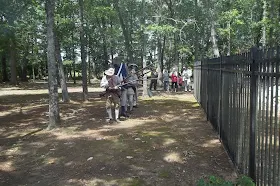Greetings my friends and fellow travelers.
On Saturday, May 28th, my US Memorial Day weekend travels took me next door to Lancaster County, South Carolina.
Most people in South Carolina spent the weekend enjoying the sunshine at beautiful Myrtle Beach a couple hours away (or at least just Saturday because of the wet weather brought ashore by Tropical Depression Bonnie effecting the rest of the weekend). Some had cookouts at family reunions.
Yours truly spent the morning and early part of Saturday afternoon of US Memorial Day weekend with roughly 60 or so people -- many of them well past their 50s -- honoring fallen American soldiers.
It was my honor to attend the 236th Anniversary commemoration of the Battle of the Waxhaws, also better known locally as Buford's Massacre, sponsored by the South Carolina Society Sons of the American Revolution.
God blessed us with good weather as we showed our respect to the men being honored that morning -- the Virginian soldiers of Colonel Abraham Buford's command that were mercilessly slaughtered in a largely one-sided 15 minute battle on that site on the afternoon of Monday, May 29, 1780 by the British Legion under the command of Lt. Colonel Banastre Tarleton. At the site of the battle 84 of the 113 Continentals killed on the battlefield are buried in a mass grave.
On Saturday, May 28th, my US Memorial Day weekend travels took me next door to Lancaster County, South Carolina.
Most people in South Carolina spent the weekend enjoying the sunshine at beautiful Myrtle Beach a couple hours away (or at least just Saturday because of the wet weather brought ashore by Tropical Depression Bonnie effecting the rest of the weekend). Some had cookouts at family reunions.
Yours truly spent the morning and early part of Saturday afternoon of US Memorial Day weekend with roughly 60 or so people -- many of them well past their 50s -- honoring fallen American soldiers.
It was my honor to attend the 236th Anniversary commemoration of the Battle of the Waxhaws, also better known locally as Buford's Massacre, sponsored by the South Carolina Society Sons of the American Revolution.
God blessed us with good weather as we showed our respect to the men being honored that morning -- the Virginian soldiers of Colonel Abraham Buford's command that were mercilessly slaughtered in a largely one-sided 15 minute battle on that site on the afternoon of Monday, May 29, 1780 by the British Legion under the command of Lt. Colonel Banastre Tarleton. At the site of the battle 84 of the 113 Continentals killed on the battlefield are buried in a mass grave.
Perhaps one of the most touching moments of the service was the scattering of Virginian soil on the mass grave by two descendants of a Virginian Continental soldier buried at the site. A reminder that our shared Southern heritage and the love we hold for those who came before us runs deep.
The following are some of the great photos I managed to get that day before my camera died -- I kinda forgot to take spare batteries, but luckily the ones I had survived till the end of the service.
The site of the Battle of the Waxhaws was added to the National Register of Historical Places in 1990 and is maintained today by the good work of the Friends of Buford Massacre Battleground...which this blogger is proudly a member.
The site of the battle and the mass grave are located 9 miles east of Lancaster, SC, at the corner of SC 9 and Rt. 522 in Lancaster County.
The site of the battle and the mass grave are located 9 miles east of Lancaster, SC, at the corner of SC 9 and Rt. 522 in Lancaster County.


















































